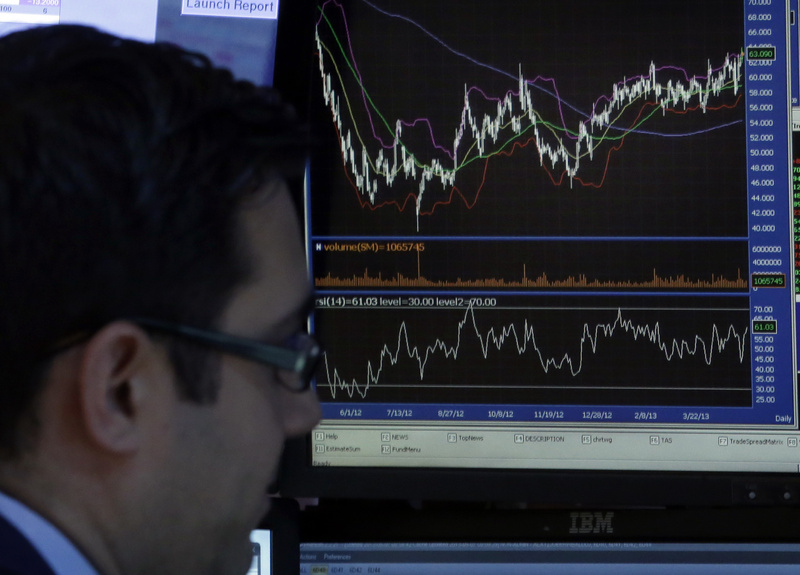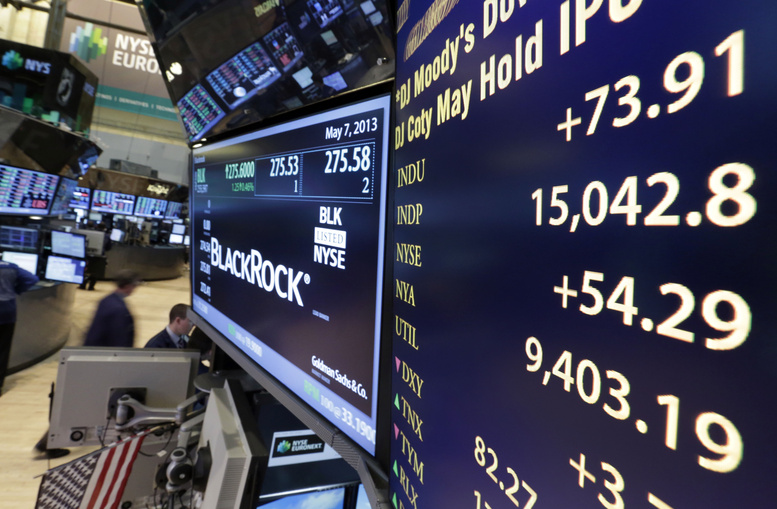NEW YORK — The Dow Jones industrial average punched through another milestone Tuesday, closing above 15,000 for the first time just two months after recovering the last of its losses from the 2008 financial crisis.
Good economic reports, strong corporate earnings and fresh support from central banks helped ease investor concerns about another economic slowdown. Many had been on the lookout for signs that a spring swoon would derail the rally, as happened in each of the past three years.
Instead, the Dow continued its epic ascent of 2013, which has seen it climb 1,952 points – almost 15 percent – since Jan. 1.
“The thing that’s been driving stocks is rising confidence,” said James Paulsen, chief investment strategist at Wells Capital Management. “Economic growth, job creation and the housing market have been better than expected.”
The Dow closed at 15,056.20, up 87.31 points, or 0.6 percent. The Standard & Poor’s 500 index added 8.46 points to a record 1,625.96, a gain of 0.5 percent. It has jumped 199 points this year, or 14 percent.
The record close extends the stock market’s comeback from the depths of the financial crisis. Both indexes reached all-time highs earlier this year, then kept rising, largely driven by optimism that the U.S. economy will keep gaining strength.
“We don’t think people are giving enough credit to the strength of the economy,” said Ryan Detrick, a senior technical strategist at Schaeffer’s Investment Research. “We still like the market.”
Detrick said he was particularly encouraged by the resurgence in smaller stocks, which suggested a broad recovery beyond larger companies. The Russell 2000 index gained eight points to close at 967.82. It has risen 14 percent this year.
The S&P has climbed higher for six straight months – the longest stretch of gains since a seven-month run that started in March 2009, when the market hit a financial crisis low, and ended in October 2009.
All 10 industries in the S&P 500 have joined in the rally. Health-care companies have led the way, up 19 percent.
The Dow, S&P 500 and Russell 2000 index of small companies are all at record highs. The sole exception is the tech-heavy Nasdaq, which remains far below the peaks it scaled in the dot-com bubble.
Six years have passed since the Dow closed above 14,000 for the first time.
Tuesday’s gains piled up with the growing realization among investors that the traditional threats to a rising market – higher interest rates, falling profits, a possible recession – are unlikely to appear anytime soon. What’s more, with interest rates near record lows, investors see few other places to put their money.
In a round of interviews on Monday, investor Warren Buffett said the stock market looked “reasonably priced” even after its surge. But, Buffett added, people pay too much attention to markets reaching highs. They ought to pay attention when markets hit new lows.
“That’s when stocks are getting cheaper,” Buffett told CNBC. “That’s when stocks are going on sale. But people do get more excited when they see new highs.”
More than 400 of the S&P 500 companies have turned in first-quarter results, and 7 out of 10 have beaten Wall Street’s earnings expectations, according to S&P Capital IQ. Those analysts estimate that earnings increased 5 percent in the first quarter and will pick up their pace through the rest of the year.
News of stronger hiring over the past three months briefly propelled the Dow over 15,000 on Friday, but it ended the week below that mark.
On Tuesday, the U.S. market followed Japanese and European indexes higher after they responded to good news about central bank stimulus and the German economy. The U.S. also got a lift from higher quarterly profits at satellite TV company DirecTV and watchmaker Fossil.
Fossil stock leapt $8.92, or 9 percent, to $107.88 after the company said higher sales lifted its earnings.
DirecTV, the country’s largest provider of satellite TV services, surged $3.99, or 7 percent, to $61.95 after its earnings beat analysts’ expectations. The company reported more subscribers in the U.S. and Latin America.
For the Dow, it was the 17th straight Tuesday of increases. The only day of the week with a longer series of consecutive gains is Wednesday, which logged a streak of 24 in 1968, Detrick said.
In other trading, the Nasdaq composite rose 3.66 points to 3,396.63, up 0.1 percent. That’s still a far cry from its dot-com era high of 5,048 from March 10, 2000.
Japanese stocks surged, pushing the Nikkei above 14,000 for the first time in nearly five years. The Nikkei has jumped 36 percent this year after the Bank of Japan announced a new aggressive monetary policy to get the country out of its two-decade stagnation.
In Europe, Germany’s main DAX index touched a record of 8,195, bouyed by surprisingly strong industrial orders, before falling back slightly.
In the market for U.S government bonds, the yield on the 10-year U.S. Treasury note edged up to 1.78 percent from 1.76 percent in late Monday trading. Optimism over the U.S. economy has yanked the yield up over the past week, as traders shift money out of the safety of the Treasury market. The yield sank to its low for the year, 1.63 percent, last Thursday.
Copy the Story LinkSend questions/comments to the editors.




Success. Please wait for the page to reload. If the page does not reload within 5 seconds, please refresh the page.
Enter your email and password to access comments.
Hi, to comment on stories you must . This profile is in addition to your subscription and website login.
Already have a commenting profile? .
Invalid username/password.
Please check your email to confirm and complete your registration.
Only subscribers are eligible to post comments. Please subscribe or login first for digital access. Here’s why.
Use the form below to reset your password. When you've submitted your account email, we will send an email with a reset code.